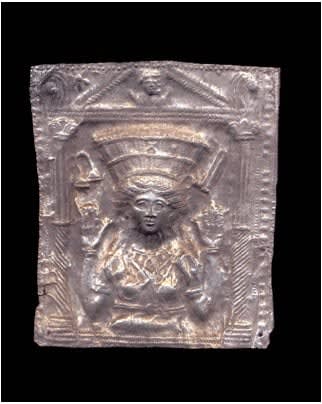Roman Silver Votive Plaque Depicting a Goddess, 1st Century CE
Silver
6.375 x 7
X.0165
Small votive plaques forged from precious metals such as this one were common to the regions of the western Black Sea coast under Roman control. Scholars believe that the images...
Small votive plaques forged from precious metals such as this one were common to the regions of the western Black Sea coast under Roman control. Scholars believe that the images of a woman gently hammered onto the metal plaques in a technique known as repoussé likely represents the Phyrigian goddess Cybele. As Hellenistic influence began to infiltrate Asia Minor, the Anatolian cult of the mother goddess, which can be traced back to the Neolithic era, remained a vital force. Based on the late Hittite goddess Kubaba, Cybele represented the most contemporary adaptation of this ancient fertility goddess. Called the Great Mother, she was one of the few Eastern deities whose cult was absorbed into the Roman pantheon almost fully intact.
Here, she is depicted in the form of a woman crowned with a kalathos, a type of tiered basket symbolic of her fertility. She wears a garment belted just below her breasts and holds her arms in front of her, revealing her open palms to the viewer. She is framed by a stylized shrine composed of two elaborate columns with volute capitals that support a triangular pediment that is decorated with a bust of the moon goddess Selene. A cymbal and a flute appear in the field on either side of the goddess, while a fish is present below. The Great Mother Goddess of Anatolian mythology was worshipped before history was first recorded. Over time, her name and image changed as her cult was adopted and adapted by the varying civilizations that at one time ruled the land of Asia Minor. Here, on this silver votive plaque, we witness this deity as she appeared to the Romans. Centuries later, this portrayal of the ancient Mother Goddess would survive in the form of the Virgin Mary, who is traditionally represented in Eastern Orthodox art forming a similar gesture.
Here, she is depicted in the form of a woman crowned with a kalathos, a type of tiered basket symbolic of her fertility. She wears a garment belted just below her breasts and holds her arms in front of her, revealing her open palms to the viewer. She is framed by a stylized shrine composed of two elaborate columns with volute capitals that support a triangular pediment that is decorated with a bust of the moon goddess Selene. A cymbal and a flute appear in the field on either side of the goddess, while a fish is present below. The Great Mother Goddess of Anatolian mythology was worshipped before history was first recorded. Over time, her name and image changed as her cult was adopted and adapted by the varying civilizations that at one time ruled the land of Asia Minor. Here, on this silver votive plaque, we witness this deity as she appeared to the Romans. Centuries later, this portrayal of the ancient Mother Goddess would survive in the form of the Virgin Mary, who is traditionally represented in Eastern Orthodox art forming a similar gesture.
